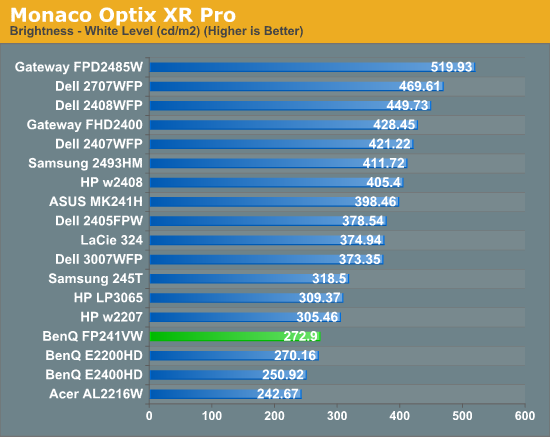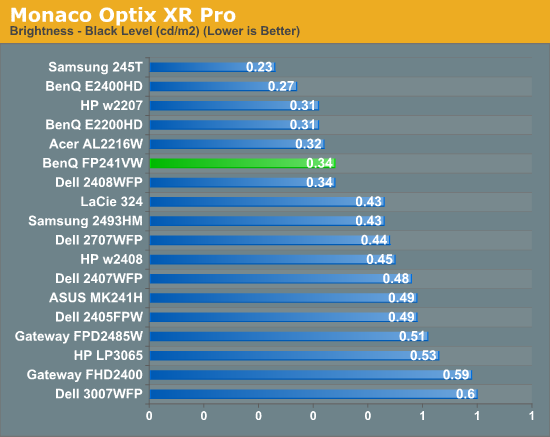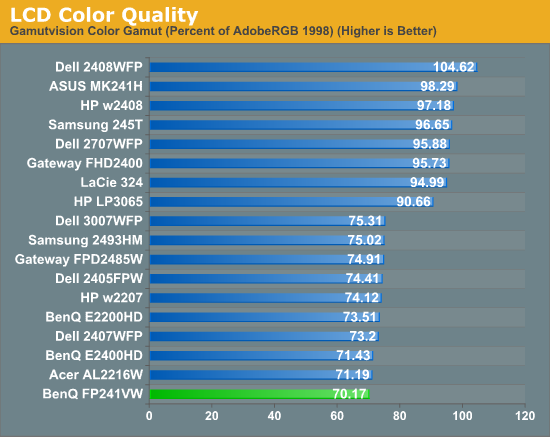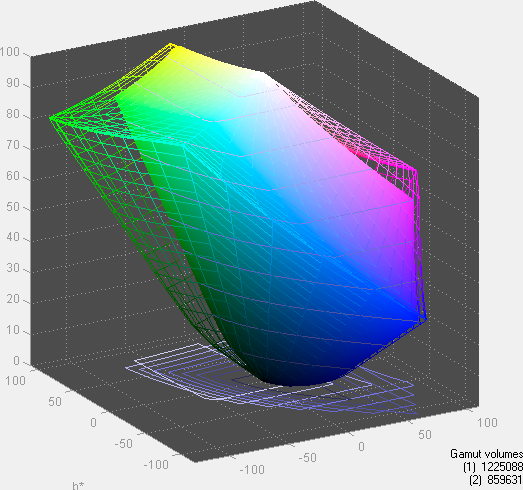Brightness and Contrast Ratio
For the brightness, contrast, and color accuracy tests, we depend on a hardware colorimeter and software to help calibrate the displays. We use a Monaco Optix XR (DTP-94) colorimeter and Monaco Optix XR Pro software, and we also test with ColorEyes Display Pro. Results in nearly every case have been better with Monaco Optix XR Pro, so for this article we're skipping the ColorEyes Display Pro results. We didn't perform a complete evaluation of the FP241VW, so we're missing maximum/minimum brightness results, but in general the display performs similarly to other LCDs.



Don't pay too much attention to the white/black graphs, as they are merely reference points for how the displays perform at certain settings. Like many other LCDs, the FP241VW has a "normal" brightness level of ~270 nits, which is more than sufficient and is actually brighter than what most users prefer to use in an office environment. You can reach the advertised 500 nits brightness if you adjust contrast and color levels as well. More important than brightness levels is the contrast ratio at the various settings. We measured a contrast ratio of 800:1 with the FP241VW, which is a decent result placing it in the lower mid section of our charts. While higher scores are better, in reality anything above 500 is sufficient for most users (i.e. the HP LP3065 that we like is at the bottom of the chart). Also, we wouldn't worry about any advertised dynamic contrast ratio numbers - at least not if you want consistent colors.
Color Gamut
Below is a comparison of color gamut for the LCDs we've tested. We use Gamutvision, a utility developed by Imatest LLC, to calculate color gamut. We compare the color profiles of the LCDs to the Adobe RGB 1998 color profile and report the results as a percentage - higher being better.


So far, color gamut has generally fallen into one of two categories: either +/-95% or +/-75%. Color gamut is determined almost exclusively by the backlighting, and the BenQ FP241VW falls short of other high-end LCDs in this area. In fact, it's at the bottom of the chart (though the difference between 70% and 75% isn't something you're likely to notice, so the bottom grouping essentially is a tie). For the original price, we would expect better, and if AU Optronics updates this particular panel we would definitely like to see a better backlight. Ideally, what we would like to see from more manufacturers is the use of LED backlighting - you can get extremely high color gamuts using RGB LEDs, and power requirements are also lower than traditional CCFL backlights. It's important to keep things in perspective, however: 70% may seem very low, but if you are using the standard sRGB profile (Windows' default) these LCDs look fine. It's only in applications like Adobe Photoshop with its expanded color space that you might notice a difference between the display color gamuts.










114 Comments
View All Comments
alantay - Wednesday, June 17, 2009 - link
"For better or worse, LCDs are here to stay and CRTs are a dying breed"A bit off topic to the review itself, but since you mentioned it: At the time LCDs were taking over the market, they were 2-3 times more expensive than CRTs. They absolutely could not compete in speed (input lag was unknown before LCDs came around), they absolutely could not compete in viewing angles (idem), They could not compete in color and contrast, they absolutely could not compete in "natural look" (things look perfectly natural in a CRT monitor and very unnatural in a LCD one). And obviously, they could not compete in price. Yet, 90%+ of the people buying a new monitor were choosing an LCD. Why?
The obvious advantage of LCDs was exterior design. They're very good looking monitors when compared with the ugly and bulky CRTs. But then again, is exterior design so important for something like a monitor as to pay 3 times more for something 10 times worse??? Oh, LCDs were a new technology, I guess some people also like anything new (even if worse). But...
Still a mystery to me... (writing this using my -very- old CRT).
Rindis - Thursday, June 18, 2009 - link
"The obvious advantage of LCDs was exterior design. They're very good looking monitors when compared with the ugly and bulky CRTs."No, the obvious advantage is weight and volume. It is much easier to find a place to park a screen (especially a larger one), when you don't have have as much room in back of it as to the sides.
strikeback03 - Thursday, June 18, 2009 - link
Now I'll admit that I never used a top-quality CRT (best I have ever used were some large ViewSonics) but IMO the only advantage they hold over even 5-year old LCDs is the viewing angles (vs TN). LCDs don't vibrate all over the place, they don't need fooling around with the video card to keep refresh rates up, text is actually sharp, and, of course, you can get a decent sized one without worries about lifting it.TA152H - Saturday, June 20, 2009 - link
CRTs are much better than LCDs at certain things. The reverse is also true.If you have very good eyes, looking at an LCD is like looking through a screen door. You can see the small divisions between pixels easily.
By contrast, CRTs have much richer pictures, without these barriers.
I hated LCDs, but bought one anyway just to give them a try. When I am using it, I get used to all the flaws of it, and don't mind it at all. Then when I look at a CRT, I'm annoyed by the moire issues, and other irregularities. This is at higher resolutions though, at lower resolutions, the CRT is just better except for logistics. So, I really prefer the LCD when that's what I've been using. But, if I am using a CRT, and then go to an LCD, it looks lifeless and dull, and the screen door issue irritates the Hell out of me.
Anything at or less than 800x600 is clearly the advantage of the CRT. It's got few if no issues, and has much better color saturation. Above that though, where it really matters, it's really personal preference. No one can say that one is clearly better than the other, they are better at different things and we all have to make a choice (well, it's almost been made for us now). Heck, I can't even say which I prefer. I do like the low glare of LCDs a lot though, but now I see some with mirror like finishes. That's really strange. I don't know why people would want these, especially on a laptop with a lot of ambient light.
Griswold - Wednesday, June 17, 2009 - link
No, you forgot the number one reason: no headaches and eyestrain compared to those god forsaken CRTs.The0ne - Thursday, June 18, 2009 - link
yep, good riddance to those CRT monitors. yay for my eyes! :)JarredWalton - Wednesday, June 17, 2009 - link
It depends on what you're comparing: a top quality CRT to a typical LCD at launch, yes, the CRT would win in most areas. But...LCDs have perfect geometry when using a digital signal, they weigh less, brightness levels look better on most models, and did I mention size? LOL... Actually, the geometry adjustment stuff on CRTs is one thing I'm happy to NEVER have to do again. Trapezoidal, rotational, pincushion, etc. distortion sucked, and you had to adjust for each resolution and refresh rate.
What I miss - and the only thing I really miss! - is the 100+ Hz refresh rates. Even the current 120Hz LCDs don't generally do a 120Hz signal (that would require dual-link DVI at 1920x1200); they just refresh the content more frequently. (I might be wrong on this - some displays may actually support a 120Hz signal?) Oh, and I suppose I also miss true blacks on occasion, but with most games being developed on LCDs there were times when having "true black" was a problem (i.e. Doom 3 - I thought the game was unplayable until I tried it on my then-new 2405FPW LCD).
Mastakilla - Wednesday, June 17, 2009 - link
you are right about most 120hz displays not being really 120hzyou are also right about real 120hz @ 1920x1200 requiring dual link DVI
there do exist some REAL 120hz 1650x1080 displays though (I think Viewsonic has one for example)
TA152H - Wednesday, June 17, 2009 - link
If you want to find a quality monitor, review an Eizo. They've been the best monitors for 20 years, and you can't compare junk from BenQ, ViewSonic, et al with them. The only problem is cost, but, if you're just focused on quality, nothing comes close.Prove me wrong. Review one of their high end monitors and then see if you hit the UPS man over the head when he comes to take it back.
Once you get used to them, it's a hard habit to break, and an expensive habit to keep.
erple2 - Wednesday, June 17, 2009 - link
That was true 20 years ago when we all had CRT's - it was very hard to beat an Eizo / Nanao in picture quality.However, the LCD era kind of changed all of that. Eizo makes some nice panels, sure, but they're really not the best. There's a couple of superb NEC monitor out there at the 1200-2200 price range (the 2490 and 3090 models), plus at least 2 HP 24" monitors (the 2475w and 2480zs) that are as good or better than anything Eizo puts out.
I think the "problem" now is that there are only a few manufacturers of the panels, so there's only so much any reseller can do.